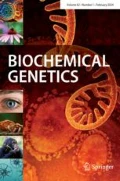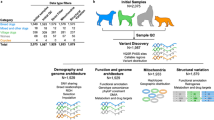Abstract
We are developing a genetic map of the dog based partly upon markers contained within known genes. In order to facilitate the development of these markers, we have used polymerase chain reaction (PCR) primers designed to conserved regions of genes that have been sequenced in at least two species. We have refined the method for designing primers to maximize the number that produce successful amplifications across as many mammalian species as possible. We report the development of primer sets for 11 loci in detail:CFTR, COL10A1, CSFIR, CYP1A1, DCN1, FES, GHR, GLB1, PKLR, PVALB, andRB1. We also report an additional 75 primer sets in the appendices. The PCR products were sequenced to show that the primers amplify the expected canine genes. These primer sets thus define a class of gene-specific sequence-tagged sites (STSs). There are a number of uses for these STSs, including the rapid development of various linkage tools and the rapid testing of genomic and cDNA libraries for the presence of their corresponding genes. Six of the eleven gene targets reported in detail have been proposed to serve as “anchored reference loci” for the development of mammalian genetic maps [O'Brien, S. J.,et al., Nat. Genet. 3:103, 1993]. The primer sets should cover a significant portion of the canine genome for the development of a linkage map. In order to determine how useful these primer sets would be for the other genome projects, we tested the 11 primer sets on the DNA from species representing five mammalian orders. Eighty-four percent of the gene-species combinations amplified successfully. We have named these primer sets “universal mammalian sequence-tagged sites” because they should be useful for many mammalian genome projects.
Similar content being viewed by others
References
Alcalay, M., Antolini, F., Van de Ven, W. J., Lanfrancone, L., Grignani, F., and Pelicci, P. G. (1990). Characterization of human and mouse c-fes cDNA clones and identification of the 5′ end of the gene.Oncogene 5267.
Asher, J. H. J., and Friedman, T. B. (1990). Mouse and hamster mutants as models for Waardenburg syndromes in humans.J. Med. Genet. 27618.
Barendse, W., Armitage, S. M., Kossarek, L. M., Shalom, A., Kirkpatrick, B. W., Ryan, A. M., Clayton, D., Li, L., Neibergs, H. L., Zhang, N., Grosse, W. M., Weiss, J., Creighton, P., McCarthy, F., Ron, M., Teale, A. J., Fries, R., McGraw, R. A., Moore, S. S., Georges, M., Soller, M., Womack, J. E., and Hetzel, D. J. S. (1994). A genetic linkage map of the bovine genome.Nat. Genet. 6227.
Bassam, B. J., and Caetano-Anolles, G. (1993). Automated “hot start” PCR using mineral oil and paraffin wax.Biotechniques 1430.
Bergenhem, N. C. H., Venta, P. J., Hopkins, P. J., and Tashian, R. E. (1992). Variation in coding exons of two electrophoretic alleles at the pigtail macaque carbonic anhydrase I locus as determined by direct, double-stranded sequencing of polymerase chain reaction (PCR) products.Biochem. Genet. 30279.
Boyer, G., Nonneman, D., Shibuya, H., Stoy, S. J., O'Brien, D., and Johnson, G. S. (1995). A PCR-RFLP marker for the erythroid aminolevulinate synthase gene (ALSA2) on canine chromosome X.Anim. Genet. 26206.
Breslauer, K., Frank, R., Blocker, H., and Markey, L. A. (1986). Predicting DNA duplex stability from the base sequence.Proc. Natl. Acad. Sci. USA 833746.
Buchanan, F. C., Adams, L. J., Littlejohn, R. P., Maddox, J. F., and Crawford, A. M. (1994). Determination of evolutionary relationships among sheep breeds using microsatellites.Genomics 22397.
Collins, D. W., and Jukes, T. H. (1994). Rates of transition and transversion in coding sequences since the human-rodent divergence.Genomics 20386.
Day, A. A., McQuillan, C. I., Termine, J. D., and Young, M. R. (1987). Molecular cloning and sequence analysis of the cDNA for small proteoglycan II of bovine bone.Biochem. J. 248801.
Deschenes, S. M., Puck, J. M., Dutras, A. S., Somberg, R. L., Felsburg, P. J., and Henthorn, P. S. (1994). Comparative mapping of canine and human proximal Xq and genetic analysis of canine X-linked severe combined immunodeficiency.Genomics 2362.
Dietrich, W., Katz, H., Lincoln, S. E., Shin, H.-P., Friedman, J., Dracopoli, N. C., and Lander, E. S. (1992). A genetic map of the mouse suitable for typing intraspecific crosses.Genetics 131423.
Ellegren, H., Johansson, M., Sandberg, K., and Andersson, L. (1992). Cloning of highly polymorphic microsatellites in the horse.Anim. Genet. 23133.
Fujita, M., Loechel, R., McFarlin, K., Brewer, G. J., Venta, P., and Yuzbasiyan-Gurkan, V. (1996). Assignment and localization of a set of genes to canine chromosomes using fluorescent in situ hybridization.Mammal. Genome 7268.
Gu, X., and Li, W.-H. (1993). Higher rates of amino acid substitution in rodents than in humans.Mol. Phylogen. Evol. 1211.
Holmes, N. G., Mellersh, C. S., Humphreys, S. J., Holliman, A., Curtis, R., and Sampson, J. (1992). Isolation and characterization of microsatellites from the canine genome.Anim. Genet. 24289.
ISGN (1987). Guidelines for human gene nomenclature: An international system for human gene nomenclature (ISGN, 1987).Cytogenet. Cell Genet. 4611.
Li, W.-H., and Grauer, D. (1987).Fundamentals of Molecular Evolution Sinauer Associates, Sunderland, MA.
Meera Khan, P., Brahe, C., and Wijnen, L. M. M. (1984). Gene map of the dog: Six conserved and three disrupted syntenies.Cytogenet. Cell Genet. 37537.
Morell, R., Friedman, T. B., Moeljopawiro, S., Hartono, Soewito, and Asher, J. H., Jr. (1992). A frameshift mutation in the HuP2 paired domain of the probable human homolog of murine Pax-3 is responsible for Waardenburg syndrome type 1 in an Indonesian family.Hum. Mol. Genet. 1243.
Murray, N. E., Brammer, W. J., and Murray, K. (1977). Lambdoid phages that simplify the recovery of in vitro recombinants.Mol. Gen. Genet. 15653.
O'Brien, S. J. (1986). Molecular genetics in the domestic cat and its relatives.Trends Genet. 2137.
O'Brien, S. J., Womack, J. E., Lyons, L. A., Moore, K. J., Jenkins, N. A., and Copeland, N. G. (1993). Anchored reference loci for comparative genome mapping in mammals.Nat. Genet. 3103.
Olsen, M., Hood, L., Cantor, C., and Botstein, D. (1989). A common language for physical mapping of the human genome.Science 2451434.
Ostrander, E. A., Sprague, G. F., and Rine, J. (1993). Identification and characterization of dinucleotide repeat (CA)n markers for genetic mapping in dog.Genomics 16207.
Roebroek, A. J. M., Schalken, J. A., Onnekink, C., Bloemers, H. P. J., and Van de Ven, W. J. (1987). Structure of the felinec-fes/fps proto-oncogene: Genesis of a retroviral oncogene.J. Virol. 612009.
Rothuizen, J., Wolfswinkel, J., Lenstra, J. A., and Frants, R. R. (1994). The incidence of mini-and micro-satellite repetitive DNA in the canine genome.Theor. Appl. Genet. 89403.
Sambrook, J., Fritsch, E. F., and Maniatis, T. (1989)Molecular Cloning. A Laboratory Manual (2nd ed.), Cold Springs Harbor Laboratory Press, Cold Springs Harbor, NY.
Serikawa, T., Kuramoto, T., Hilbert, P., Mori, M., Yamada, J., Dubay, C. J., Lindpainter, K., Ganten, D., Guenet, J.-L., Lathrop, G. M., and Beckmann, J. S. (1992). Rat gene mapping using PCR-analyzed microsatellites.Genetics 131701.
Uchida, T., Komori, M., Kitada, K., and Kamataki, T. (1990). Isolation of cDNAs coding for three different forms of liver microsomal cytochrome P-450 form polychlorinated biphenyl-treated beagle dogs.Mol. Pharmacol. 38644.
Weissbach, J., Gyapay, G., Dib, C., Vignal, A., Morissette, J., Millasseau, P., Vaysseix, G., and Lathrop, M. (1992). A second-generation linkage map of the human genome.Nature 359794.
Whitney, K. M., Goodman, S. A., Bailey, E. M., and Lothrop, C. D., Jr. (1994). The molecular basis of canine pyruvate kinase deficiency.Exp. Hematol. 22866.
Winterø, A. K., Fredholm, M., and Thomsen, P. D. (1991). Variable (dG-dT)n-(dC-dA)n sequences in the porcine genome.Genomics 12281.
Yuzbasiyan-Gurkan, V., Wagnitz, S., Blanton, S. H., and Brewer, G. J. (1993). Linkage studies of the esterase D and retinoblastoma genes to canine copper toxicosis: a model for Wilson disease.Genomics 1586.
Author information
Authors and Affiliations
Rights and permissions
About this article
Cite this article
Venta, P.J., Brouillette, J.A., Yuzbasiyan-Gurkan, V. et al. Gene-specific universal mammalian sequence-tagged sites: Application to the canine genome. Biochem Genet 34, 321–341 (1996). https://doi.org/10.1007/BF02399951
Received:
Revised:
Issue Date:
DOI: https://doi.org/10.1007/BF02399951




